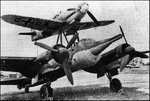Bob_Semple_Airplane
Airman
- 13
- Apr 3, 2013
So in WWII the Germans stuck fighters on top of unmanned bombers stuffed with generous quantities of high explosive.

I figure they had big cranes at the factories to hoist up the fighters to weld or bolt the structures together, and then flew the completed airframes out to forward operating bases. But how did the pilots climb up into those things? I don't see any ladders!
Edit: wrong forum, maybe should have gone in Aviation
I figure they had big cranes at the factories to hoist up the fighters to weld or bolt the structures together, and then flew the completed airframes out to forward operating bases. But how did the pilots climb up into those things? I don't see any ladders!
Edit: wrong forum, maybe should have gone in Aviation
Last edited:

